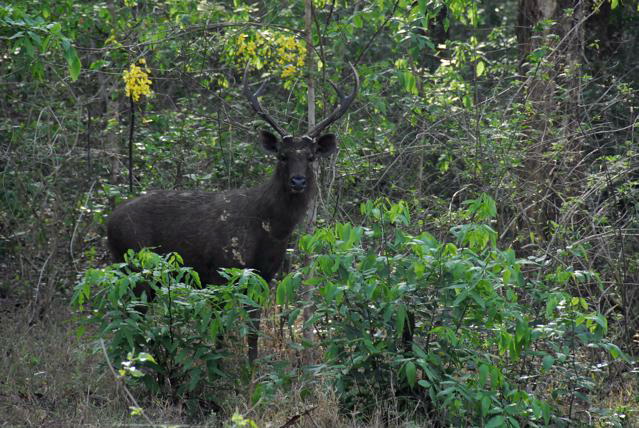|
| 질의: Water dragon | 결과: 55번째/58 | |
Sambar Deer (Cervus unicolor) - Wiki
| 제목: | Sambar Deer (Cervus unicolor) - Wiki
| |

| 해상도: 639x428
파일크기: 163082 Bytes
촬영일: 2006:04:17 07:54:18
사진기: NIKON D200 (NIKON CORPORATION)
F number: f/5.7
Exposure: 10/1250 sec
Focal Length: 2000/10
등록시간: 2007:07:02 11:56:18
|
Sambar Deer
From Wikipedia, the free encyclopedia
[Photo] Sambar in forest. Photo by Stephen Cooper. Date: 17 April 2006.
Sambar (also sambur, sambhur), is the common name for several large dark brown and maned Asian deer, particularly for the Indian species, which attains a height of 102 to 160 cm (40 to 63 in) at the shoulder and may weigh as much as 272 kg (600 lb). The coat is dark brown with chestnut marks on the rump and underparts. The large, rugged antlers are typically rusine, the brow tines being simple and the beams forked at the tip. In some specimens the antlers exceed 101 cm (40 in). Sambars are primarily browsers that live in woodlands and feed mainly on coarse vegetation, grass, and herbs. They are diurnal animals who live in herds of 5-6 members, grazing on grass, sprigs, fruit and bamboo buds. These deer are seldom far from water and, although primarily of the tropics, are hardy and may range up to high elevations such as the mixed forests in the Himalayan Mountains. These deer are also found in similar mountain "temperate forest" environments in China, Thailand, and Taiwan. In Taiwan, sambar along with sika deer have been raised on farms for their antlers, which they drop annually in April/May.
Reproduction
Mating Period: November/December.
Sambar males defend rutting territories and attempt to attract females by vocal and olfactory displays. With the exception of the Philippine Spotted Deer, sambar fawns are not spotted at birth.
Species Distribution
The Indian Sambar (Cervus unicolor) inhabit much of southern Asia (as far north as the south-facing slopes of the Himalayan Mountains), mainland Southeast Asia (Burma, Thailand, Indochina, the Malay Peninsula), southern China (including Hainan Island), Taiwan, and the islands of Sumatra and Borneo in Indonesia. This deer has been seen congregating in large herds in protected areas such as national parks and reserves in India, Sri Lanka, and Thailand. The subspecies of Indian sambar in India and Sri Lanka are the largest of the genus with the largest antlers. Populations that inhabit the Malay Peninsula, Sumatra, and Borneo seem to have the smallest antlers in proportion to their body size. The subspecies in Taiwan (or Formosa) is the smallest Cervus unicolor.
There are two small, separate but similar species, the Philippine Sambar (Cervus mariannus) and the Philippine Spotted Deer (also known as the Visayan Spotted Deer or Alfred's Sambar) (Cervus alfredi), that inhabit the Philippines|Philippine Islands. Both deer are smaller than the Formosan sambar.
The Rusa Deer, or Sunda Sambar (Cervus timorensis), is slightly smaller than the Indian Sambar and inhabits the islands of Java and Bali in Indonesia and, unlike the latter three species, it is predominantly a grazer and forms the largest herds. This deer probably originated in Java but was widely introduced to several adjacent islands as well as the Molucca Islands and Lesser Sunda Islands. Herds gather in open savannas but will retreat to adjacent dry deciduous woodlands or seasonal mixed deciduous monsoon forests for cover. This deer is a favorite prey of the Komodo Dragon.
There is also a small herd of sambar located on St. Vincent Island in Florida. These were brought in by the former owner, before he sold the island to the Nature Conservancy.
Species in Australia and New Zealand
Sambar deer are an introduced species in both Australia and New Zealand. In Australia, hunting them is a popular sport. Large sambar trophies are very prized and taking a sambar deer in the highlands of Victoria and New South Wales (where they are most prevalent) is considered an admirable act in Australian hunting fraternities.
In New Zealand, sambar deer roam the coastal and gullies in Horowhenua, Manawatu, Rangitikei and Wanganui. Until recently they were protected, but New Zealand Department of Conservation has now removed hunting regulations surrounding them, allowing them now to be hunted year round.
http://en.wikipedia.org/wiki/Sambar_Deer
| The text in this page is based on the copyrighted Wikipedia article shown in above URL. It is used under the GNU Free Documentation License. You may redistribute it, verbatim or modified, providing that you comply with the terms of the GFDL. |
|
댓글 |
|---|
| | 손님 |
|
Scientific Name: Rusa unicolor (Kerr, 1792)
Common Names: Sambar, Indian Sambar, Sambar Deer
Synonyms: Cervus unicolor Kerr, 1792 |
^o^
동물그림창고 똑똑전화 누리집
^o^
|
|
|

